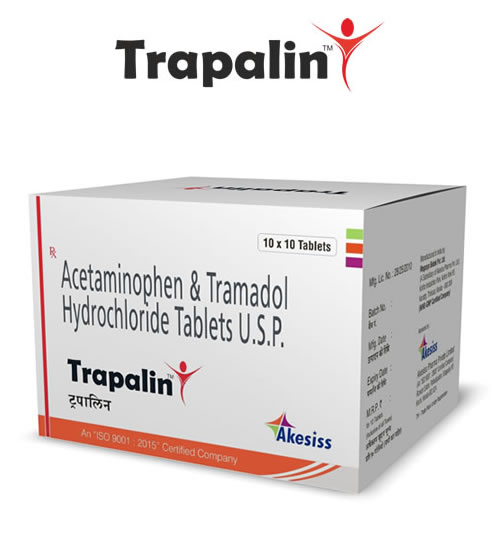COMPOSITION:
Each film coated tablet of TRAPALIN contains
Tramadol…………………37.5 mg
Paracetamol……………..325mg
The pairing of tramadol and paracetamol represents a rational complementary analgesic combination. TRAPALIN has been developed for the treatment of moderate to severe pain with dosing as needed where its incremental benefit, rapid onset combined with prolonged analgesia, is desirable.
Tramadol: is a centrally -acting analgesic agent with a prolonged analgesic effect and a slightly delayed onset of action in comparison with paracetamol. With a reduced side effect profile in comparison with conventional opioids or NSAIDs, tramadol has become a standard in the treatment of moderate to severe pain. Tramadol, with a favorable benefit/risk ratio, has been shown to be of value in treating a wide variety of pain conditions. Tramadol is especially suitable for combining with paracetamol, as their modes of action are complementary.
Paracetamol: is a proven effective non-opioid analgesic and antipyretic with rapid onset of action and an excellent safety profile. The pharmacological characteristics of paracetamol and its favorable safety profile made it the preferred combination partner rather than aspirin and NSAIDs.
PHARMACOKINETICS:
A comparison of the pharmacokinetic parameters of tramadol and paracetamol shows the suitability of such a combination. The pharmacokinetic profiles of tramadol and paracetamol are complementary, combining the rapid onset of paracetamol with the prolonged effect of tramadol. The time to achieve maximum plasma concentrations (tmax) is 30−60 minutes for paracetamol, whereas for tramadol tmax is achieved approximately after 2 hours. Furthermore, the plasma half- life (t 1/2) of tramadol of 6 hours is much longer than that of paracetamol (2 hours). Thus pairing tramadol with a rapid-onset, short-acting analgesic such as paracetamol represents a pharmacokinetically rational combination.
Bioavailability and protein binding are similar for both drugs. Both drugs are metabolized mainly via the liver, but each compound is broken down along separate metabolic pathways.
Tramadol is broken down into a series of metabolites by hepatic enzymes, via the cytochrome-P450-oxygenase system. The two important enzymes for the metabolism of tramadol are CYP2D6 and CYP3A4. Tramadol is mainly metabolized by means of N- and O-demethylation and conjugation of the O-demethylation products with glucuronic acid. Of the metabolites produced, only O-desmethyl-tramadol (M1) is pharmacologically active in vivo with analgesic properties.
Paracetamol is metabolized in the liver by three distinct pathways, glucuronide conjugation (60%), sulphate conjugation (35%), and the hepatic cytochrome-P450-dependent mixed function oxidase system. Only small amounts (<3%) of paracetamol undergo cytochrome-P450-mediated N-hydroxylation to form N-acetyl -p-benzoquinoneimine, a highly reactive intermediate. Administration of high doses of paracetamol may exceed the capacity of the liver to form conjugates. In this case, the accumulating metabolites bind to liver proteins, leading to liver necrosis.
PHARMACODYNAMICS:
Combining complementary modes of action contributes to the analgesic efficacy of TRAPALIN in treating moderate to severe pain.
Tramadol is a racemic mixture, containing two enantiomers and displaying duality of action modes. The distinct profiles of the two tramadol enantiomers combine to produce effective analgesia within a wider therapeutic range, before the onset of potentially serious Adverse effects such as respiratory depression. The (+) enantiomer of tramadol has a slightly higher affinity for the m-opioid receptor than the ( – ) enantiomer does, and also inhibits serotonin re-uptake. The (-) enantiomer has less affinity for the m-receptor and weakly inhibits serotonin re-uptake, but it also inhibits noradrenalin re-uptake more strongly than the (+) enantiomer. Thus the two enantiomers have similar properties, but in differing proportions. The analgesic effect of the two enantiomers is synergistic.
The analgesic effect of paracetamol appears to be centrally-mediated. Antinociception after paracetamol administration seems to be mediated, at least in part, by inhibition of spinal prostaglandin release, monoaminergic modulation, and/or NMDA blockade. The exact mechanism of analgesic action of paracetamol, however, remains unknown.
The combination of tramadol and paracetamol combines three complementary modes Of analgesic action:
Tramadol activates -opioid receptors
Tramadol inhibits re-uptake of noradrenalin and serotonin
Paracetamol weakly inhibits prostaglandin biosynthesis
CONVENTIONAL OPIOID MECHANISM:
Tramadol activates only weakly opioid receptors, with a higher affinity for the M-receptors, which is 6,000 times less than that of morphine, and about 10 times less than that of codeine. Therefore, it can be readily displaced from the receptor site by any other opioid which binds more strongly. This property may have useful clinical benefits in cases where it is necessary to switch to a highly potent opioid for emergency use. In an experimental model, the antinociceptive effects of tramadol are reduced by naloxone (morphine antagonist), demonstrating the opioid agonist effect. However, a significant degree of analgesia is obtained even after naloxone inhibition, demonstrating that there is a further non-opioid component to the analgesic effect.
MONOAMINERGIC PATHWAY:
Tramadol inhibits the neuronal re-uptake of noradrenaline and serotonin at the spinal level, and potentiates pre-synaptic release, thus increasing the concentrations of both of these monoaminergic neurotransmitters in the synaptic cleft, and thereby augmenting the chemical signal of the descending pain inhibitory pathways, and decreasing the ascending pain impulse.
INHIBITION OF PROSTAGLANDIN SYNTHETASE:
Paracetamol is an analgesic and antipyretic drug with a still mostly unclear mechanism of action. It appears to produce analgesia by elevation of the pain threshold. In contrast to other non-steroidal analgesics, it does not have anti – inflammatory actions. Paracetamol does not inhibit inflammatory processes, because, as a result of its chemical characteristics (not acidic), it does not accumulate in inflamed tissue. It has been speculated that one major mechanism of the analgesic activity of paracetamol is the inhibition of isoforms of the cyclo-oxygenase (COX) situated in the CNS which are involved in the synthesis of prostaglandins.
The combination of analgesic compounds with different modes of action may result in additive or synergistic effects.
INDICATIONS AND USAGE:
In the management of mild to moderate Nociceptive & Neuropathic pain


